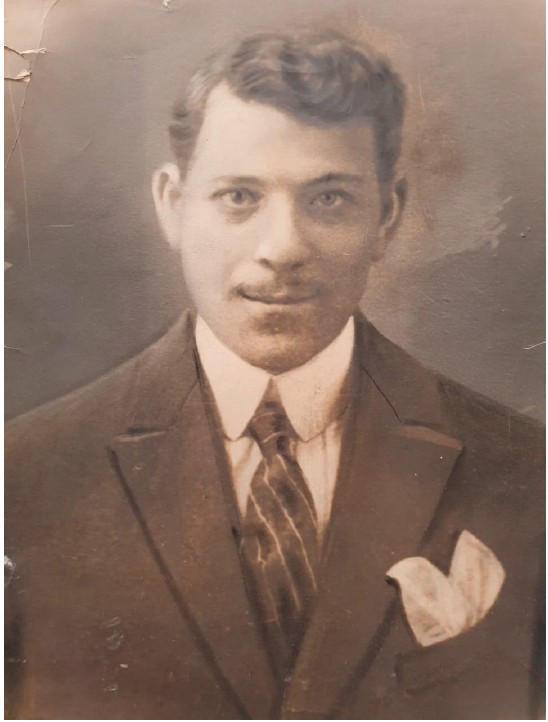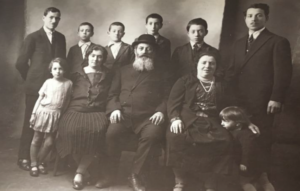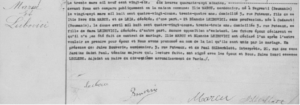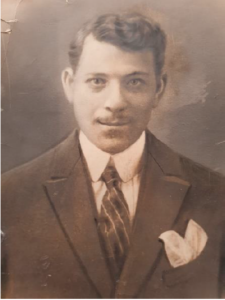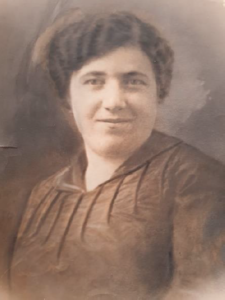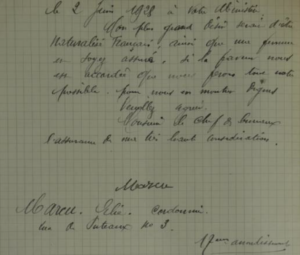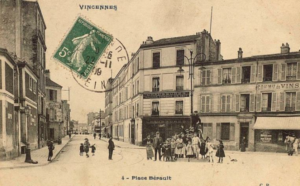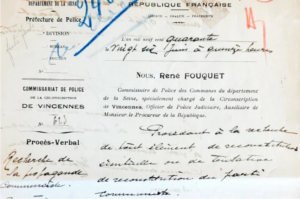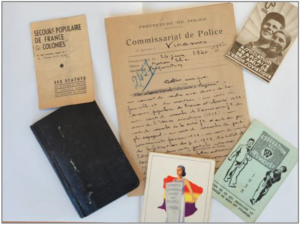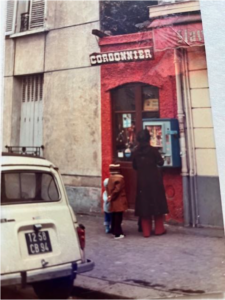Elie MARCU
The biography that you are about to read was researched and written by Isidore Berthelot, Nathan Dana, Raphaël Durand, Manèle Ghermaoui, Gwenaëlle Leclercq, Anton Muselli-Blot, Elias Oufkir, Colin Rambaud, Robin Thomas and Angela Trueba, 9th grade students at the La Cerisaie middle school in Charenton-le-Pont, in the Val-de-Marne department of France, with the guidance of Nathalie Baron and Sonia Drapier, their History and Geography teachers. It was written during the 2023-2024 school year.
We were lucky enough to track down Jean-Pierre Fayer, Elisa Marcu’s son, on the Internet. We would like to thank both him and his family for all their help with our research, for providing us with various records and for coming to our school to meet us. We would also like to thank Jacques Gragnon and Philippe Roza, who also contributed to our research. We are happy to be able to share Ilie’s biography with you. Meanwhile, some of our fellow students have written the biographies of his children, Manuel and Elisa, and these too can be found on the Convoy 77 website.
Our research was based on records from the Val de Marne Departmental archives, the French Historical Defense Service Memorial in Caen in the Normandy department of France, (DAVCC file 21P 644 268), the Shoah Memorial in Paris, the Paris Police Headquarters and the Arolsen Archives.
I- From Romania to France
1) The move to France
Ilie or Elie Marcu was born on March 27, 1892 in Negresti, in the northeast of Romania. His parents, who were Jewish, were Leia and Ilie Hers Sin Marcu.
Ilie left Romania in 1913, probably to escape the increasing anti-Semitism and to avoid having to carry out his national military service.
In a letter that we found in the Shoah Memorial archives, his daughter Elisa wrote: “My parents, originally from Romania, came to France in 1913. Because my father, who was already a socialist, didn’t want to do who knows how many years of military service”.
Photo of the Marcu family – date unknown
Source: Marcu-Fayer family
According to Jean-Pierre Fayer, Elisa’s son, Ilie arrived in France alone in 1913, while Blanche followed on later. His application for French citizenship by naturalization, dated July 19, 1927, states that he had arrived in France 14 years earlier, which confirms this hypothesis. As for Blanche, she had her first child in Paris in February 1915, and therefore must have arrived quite soon after Ilie.
The application also states that Ilie had “4 brothers from whom he has had no news and does not know if they are still alive” and “one brother, Simon, aged 38, a tailor in Serbia”.
Ilie had originally intended to move to the United States after a short stay in France, but ended up staying on in Paris because he had cousins living there.
Ilie married Blanche Leibovici in the 17th district of Paris on March 30, 1926. Blanche was born on April 12, 1892 in Codăești in Romania, a town thirty miles or so from Negresti.
Blanche and Ili’s marriage certificate
Source: Val de Marne departmental archives
Ilie and Blanche Marcu – date unknown
Source : Marcu-Fayer family
According to their naturalization application, Ilie and Blanche lived at several different addresses in Paris, but not all of them are legible.
Extract from the naturalization application file dated July 19, 1927
Their marriage certificate states that Blanche and Ilie were living at 3 rue de Puteaux in the 17th district of Paris. They and their children then moved to 12 rue du Commandant Mowat in Vincennes in the 1930s. We found the family listed in the 1936 and 1946 censuses of Vincennes, which are available in the Val de Marne departmental archives.
Extrait from the 1936 census of Vincennes
Source: Val de Marne departmental archives
The couple’s four children were all born in the 17th district of Paris.
Isaac, who was born on February 10, 1915, was the eldest. He fought in the war in Syria but then, according to Elisa’s letter, was left stranded in Avignon since the Germans stopped him from going back to Paris. He was arrested there in April 1944, interned in Drancy camp and then deported to Auschwitz on Convoy 75 on May 30, 1944. He remained there until the Soviet troops liberated the camp in January 1945. His family never heard from him again. His file from Drancy camp states that he was a plumber and lived at 20, rue Petite Fusterie in Avignon.
Jean, the second son, was born on September 12, 1918. He fought in the war in Lorraine, where he was taken prisoner. He was released and returned to Vincennes on May 8, 1945. At the time of the 1946 census he was living at 12 rue du Commandant Mowat, but then, according to later records, he moved to 92 avenue de Paris.
Élisa, who was born on March 8, 1921, survived the Second World War, during which she was an active member of the Resistance until she was deported.
Manuel, who was born on May 8, 1927, was still a high school student when he was arrested and deported. He did not survive.
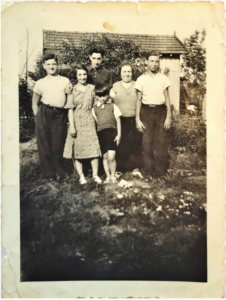
Family photo taken in Courtry: Elisa, Blanche, Jean and Manuel, with their cousins, Maurice on the left and Henri on the right – date unknown.
Source: Marcu-Fayer family
According to Ilie’s application file for French citizenship, he had applied several times since 1926, and was finally naturalized by decree on September 26, 1928, as was Blanche. The children were French from birth.
There is a hint of impatience in the various letters that Ilie sent to the French authorities.
Extract from one of Ilie’s letters, dated June 2, 1928
2) Life before the war
Even before the family moved to Vincennes, Ilie rented a 90 square foot room there, at 4 place Bérault.
He worked there as a shoemaker, or cobbler. We do not know if he ever trained as a shoemaker, but it was a trade that did not need much equipment, which might explain why he chose it. The Aryanization record for the store says that Ilie had been renting it since 1926, and that he paid 1180 francs a year in rent. We also discovered from the citizenship application file that he earned around 1000 francs a month, which would have been enough to support his family, and Blanche did not go out to work.
Postcard of the Place Bérault in Vincennes – early 20th century
Source: Val de Marne departmental archives
Elisa’s letter, mentioned above, says that Ilie had already been an active member of Romanian Socialist party before he moved to France.
He then joined the French Communist party, in which several other Marcu family members also played an active role.
Ilie and Blanche also owned a house in the countryside, in Courtry. Jean-Pierre Fayer told us that his grandparents had bought the plot of land on which they built a wooden chalet, which they later replaced with a traditional house. Several of their friends and acquaintances also had small plots of land in the Coudreaux area of Courtry. The house remained in the family until Elisa died in 2019, after which they sold it.
II- The turpitudes of war (1939-1944)
When war was declared in 1939, Ilie had recently become a widower, since Blanch had died as a result of diabetes on June 22, 1939, in the 12th district of Paris. She was buried in the Bagneux cemetery.
Ilie subsequently met a new partner, about whom we know very little, other than that Elisa mentioned her « step mother in her letter. We have no information about who she was.
Georges Sentis, in his book about Victor Gragnon, quotes Gragnon as saying that Elisa “loves to talk to me about her family, her dear, sweet daddy, her older brother (a former J.C.) who was a prisoner of war, and her “belle-doche”, as she calls her in her Parisian slang, which she sprinkles into her language when we take some time out together. The mother-in-law who used to cook food on the Sabbath so well before the restrictions”
Ilie found himself under pressure during the war due to his political convictions. We found a file about him in the Paris police headquarters archives.
At 3 p.m. on June 26, 1940, the French police raided both Ilie’s apartment and his cobbler’s workshop on the orders of René Fouquet, the Police Chief of the Seine department.
The reason given for the search, according to the instructions in the file, was “to look for any evidence of reconstitution or attempt to reconstitute the Communist Party”.
The police chief’s report states that he and his deputy found nothing at the workshop. They then asked permission to search the family home. We discovered that Ilie “rents a three-room apartment with a kitchen, entrance hall, water closets” and a storeroom. He was living with Elisa and Manuel.
The police found no weapons or other objects, but did open two locked chests of drawers. They found a membership card for the French Communist Party (for the year 1937), a membership card for the “Secours populaire de France et des colonies” (Popular relief organization of France and the colonies) (1939), a membership card for the “Association française de Paris de l’union soviétique”( (the Paris branch of the French Association for Soviet Union) (1958), another Communist Party membership card, two postcards addressed to Isaac Marcu with Communist slogans on them, two letters addressed to Jean Marcu from Jacques Gablia relating to Communist issues, and a notebook with a hammer and sickle.
The police department concluded that the Marcu family members were communists and had been politically active in the past. The search report makes no mention of the fact that they were Jewish. Although he was not a practicing Jew, Ilie was nevertheless harassed on account of his religion.
The first page of the search report
Source: Paris police headquarters archives
Photo of documents seized during the search
Source: Paris police headquarters archives
After the search relating to his Communist activities, Ilie fell victim to the policy of “Aryanization” of Jewish-owned property and businesses. The fact that the family members were not practicing Jews made no difference: the authorities still regarded them as such.
During the Occupation, a policy was put in place to transfer ownership of Jewish-owned businesses to people considered to be “Aryan”. A decree dated July 22, 1941, “relating to companies, property and assets belonging to Jews”) stated that the Commissaire Général aux Questions Juives (General Commissioner for Jewish Affairs) could decide that property could be seized and “could appoint a temporary administrator”. Soon afterwards, article 2 of a decree enacted on November 17, 1941 “regulating Jewish access to real estate”, stipulated that “buildings currently owned by Jews or acquired by them after publication of this law […] will be assigned a temporary administrator”. Housing, however, was exempt from this policy, which explains why the Marcu family was able to keep their apartment in Vincennes.
However, the management of Ilie’s shoemaking business at 4 place Bérault in Vincennes was taken over under orders from the French authorities.
On January 22, 1941, Ilie submitted a declaration requesting that he be registered as an artisan shoemaker. This is mentioned in a record dated May 12, 1941, which states that Ilie was to lock the door of his workshop, close the shutters and remove all his signs.
Mr. Rispaud, who the French authorities appointed as administrator of the business, also signed the form. He lived at 195 boulevard Pereire in Paris and was paid 500 francs to do it. He also managed three other cobbler/shoemaker businesses in Fontenay-sous-Bois.
The Aryanization file states that Ilie’s business was of no value to the French economy. After “Aryanizing” the workshop, the French government decided to close it down on June 25, 1942.
Record of the decision to close down the workshop
Source: French National archives, Pierrefitte
III- Arrest and deportation
On Sunday July 23, 1944, during a family gathering at their house in Courtry, a “White Russian” reported the Marcu family to the Gestapo, who came to arrest them as the townspeople looked on. The file from Caen mentions that the witnesses included the mayor and a Mrs. Debord, as well as other local residents.
In a letter dated March 2, 1987, Elisa wrote that she had been careless, as the Communist Party had asked her to cut all ties with her family. Might the fact that she was in Courtry, together with her father, stepmother and brother Manuel have prompted their arrest and that of fourteen other people as well?
The file on Ilie in the archives at Caen lists Adolphe Leibovici and his wife among them. They were probably related to Blanche: perhaps he was her brother.
Jean-Pierre Fayer, Ilie’s grandson, showed us a little note that he keeps to this day. This is the note Ilie threw out of the window of the vehicle in which they were taken to Drancy. It was addressed to a Mr. Pagès, who lived at 2 place Bérault in Vincennes, close to Ilie’s workshop. We know nothing about this Mr. Pagès other than that he received the note and passed it on to Ilie’s descendants.
Ilie’s note, written on July 23, 1944
Source: Marcu-Fayer family
Ilie, Manuel and Elisa were interned in Drancy on July 23, 1944. Ilie’s arrival record from Drancy includes the letter “B”, meaning that he could be deported immediately. He was assigned to room 4 on staircase 3, in the same room as Elisa and Manuel. Ilie was then transferred to room 3 on staircase 4, while Elisa was put in room 2.
All three are listed as having been deported to Auschwitz, Poland, on Convoy 77, which left France on July 31, 1944.
Drancy arrival card
Source: The Shoah Memorial in Paris
In 1957, Jean Marcu requested that his father be granted the title of political deportee (meaning that he was deported for political reasons), but the application gives no information about what happened to his father after he presumably arrived in Auschwitz. The date of death on the certificate granting Ilie the title is August 5, 1944. He was 52 years old.
Was Ilie murdered in the gas chambers as soon as he arrived? Was he deemed fit to work in the camp? We do not know.
Jean made official enquiries to find out about what happened to his father, and ask that he be awarded the honor “Mort pour la France”, meaning “Died for France”.
As a result, a death certificate was issued by the Seine High Court on April 17, 1964. It was then registered at the Vincennes registry office on June 15, 1964, with the death date given as July 31, 1944 in Drancy. This would mean that Ilie did not even board the train to Auschwitz with his children.
After the war, Elisa took over the family apartment; as for Jean, he took over the shoemaking business and continued to run his father’s business for several years, as can be seen from this photograph taken in the 1970s.
Photo of the cobbler’s workshop that Jean took over – 1970s
Source: Marcu-Fayer family


 Français
Français Polski
Polski